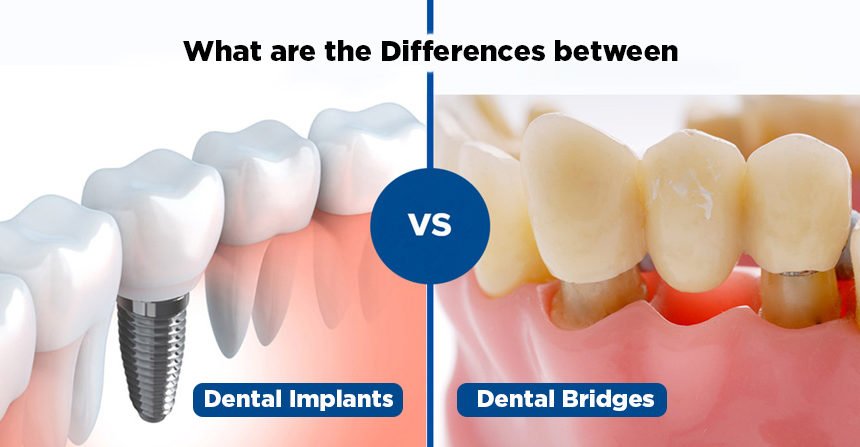What are the differences between dental implants and bridges?
A smile speaks a thousand words. A genuine and enthusiastic smile generates warmth and affection between people who are interacting with each other. On the other hand, a self-conscious smile is easily noticeable and raises questions about the person’s authenticity in certain situations.
Many times, a forceful looking smile stems from poor oral health or missing teeth. Those stuck in the latter situation can opt for a teeth replacement procedure. Over the past 30 years, the procedure to replace missing teeth has improved dramatically.
For every missing tooth, you can either get a dental bridge or a dental implant from the best implant centre in Pune or another city. But what are these procedures? How are they different from each other? Your queries shall be answered step-by-step.
What are dental implants?
Dental implants are metal posts or frames that dentists surgically position into the jawbone beneath the gums. After placing the implants, dentists then mount the replacement teeth onto them. Through this arrangement, dental implants act as artificial tooth roots, just like how screws support broken bones. By placing these implants in the jawline, they bond with the natural bone and become a sturdy base supporting multiple artificial teeth, called crowns. Since these crowns will be custom made to match the natural teeth, they will seamlessly fit inside a patient’s mouth.
The two types of dental implants are –

1.Endosteal Dental Implants
A procedure considered to be safe by India’s Dental Association, endosteal implants are surgically implanted directly into your jawbone. After that, the surrounding gum tissue is allowed to heal, upon which a second surgery connects a post to the original implant. Finally, artificial teeth are individually attached to a bridge or denture.
2.Subperiosteal Dental Implants
Subperiosteal implants don’t involve surgery. Instead, a metal frame is fitted onto the jawbone just below the gum tissues. The frame fixes to the jawbone once the gums heal itself. After that, artificial teeth are mounted to the posts attached to the frame.
Through dental implants, you can enhance your appearance, speak concisely, chew comfortably, and improve your overall oral health. Moreover, when performed by an experienced dentist, dental implant surgery is one of the safest procedures in dentistry.
What are dental bridges?
As the name suggests, a dentist ‘bridges’ the gaps between the teeth with dental bridges. It’s a procedure where a false tooth, also called as pontic, replaces the missing natural tooth, and in the process, restores its functionalities. These pontics are made from materials such as gold or porcelain, to blend them with your natural teeth aesthetically.
Dental Bridges are of four types –

1.Traditional dental bridges
Traditional bridges are a simplified procedure for the restoration of lost teeth. They are placed to fill the missing space between either side of natural teeth. Moreover, they are small, lightweight and provide chewing comfort by equally distributing your normal bite force. If you maintain optimum hygiene, a traditional dental bridge can last for a long time.
2.Cantilever dental bridges
In traditional bridges, the crown consists of the missing teeth and two anchor teeth on each end. The anchor teeth overlay over the natural teeth to support the placement of the bridge, while also acting as a removable denture. However, if there is only one anchor tooth available to support the missing tooth or teeth, cantilever bridges are an alternative.
3.Maryland dental bridges
Maryland bridges are similar to traditional bridges – except it has a metal framework instead of a gold or porcelain one. These bridges are beneficial on two fronts – a) it requires minimum adjustment for the placement of the crown, and b) it’s cost-effective as compared to traditional bridges.

4.Implant-supported dental bridges
Instead of placing crowns or frameworks, dentists surgically implant bridges for every missing tooth or teeth. It is the most reliable and most stable procedure in dentistry, which requires two surgeries – one to insert the implants in the jawbone and the other to insert the bridge. While the procedure may take several months, it is beneficial in the long run.
By placing one of the bridges mentioned above, you can restore your smile, ability to chew, speech & pronunciation, while also maintaining the shape of your face. Moreover, you can also prevent your remaining teeth from sliding out of their position.
What are the differences between dental implants and bridges?
Now that you know about each dental procedure, let’s take a look at the factors that separate them –
Practicality
Before going ahead with your dental procedure, you must get a complete consultation with your dentist and choose the most practical option. It’s because the preparation required before conducting either of these procedures couldn’t be any different. For a dental bridge procedure, the dentist has to prepare the adjacent teeth by removing the enamel to fabricate the bridge. On the other hand, a dental implant procedure requires surgical preparation before implanting the tooth or teeth in the missing space. Therefore, discuss the advantages or disadvantages of either procedure with your dentist before going ahead with the correct one.
Oral-care routine
The oral care routine post a dental bridge procedure has to be more judicious as compared to a dental implant procedure. For example, a dental bridge procedure connects at least three crowns to fill the space of the missing tooth. As a result, the design of the crown creates challenges while brushing and flossing, which makes meticulous oral care an absolute necessity. In contrast, dental implants make brushing and flossing easier around fixed and natural teeth. But, this shouldn’t discourage you from going ahead with a dental bridge procedure. Using toothbrushes with floss tip bristles will ease your cause.
Durability
When it comes to durability, dental implants provide an edge over dental bridges. The implant’s metal cylinder is made of titanium, which naturally fuses with the jawline, thanks to a process called osseointegration. Moreover, the metal used makes it resistant to decay and gum problems. On the other hand, the average life of a dental bridge is ten years.
Cost
Out of the two procedures, opting for a dental bridge is a cost-effective option over dental placement. However, it will need replacement at some point in time. On the other hand, dental implants may seem expensive at first, but their long-term durability gives them a cost-effective edge over time. Moreover, the upsurge of dental insurance plans has made dental implants an affordable procedure for the common man.
The above-mentioned points will give you enough information to make an informed decision to proceed with a suitable dental procedure. However, make sure you undergo the procedure from the Dental implants in Pune or another city. After all, your dental problems must be resolved with the best care possible!




Leave a Reply